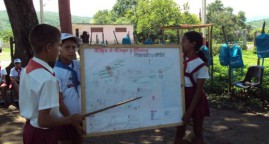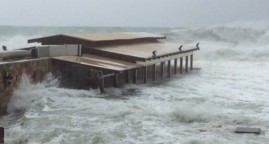2015–2016 El Niño
Early action and response for agriculture, food security and nutrition
What is El Niño?
El Niño is the warming of sea surface temperature in the tropical Pacific, which occurs roughly every 2 to 7 years, lasting from 6 to 24 months. While the main threat to food production is reduced rainfall and drought in some regions, El Niño can also cause heavy rains and flooding in other regions. Climate change can make its impact more severe. Climatologists are predicting that the 2015‒2016 El Niño event is likely to be stronger than that of 1997‒1998 – currently the worst on record – and may persist until second quarter of 2016.
Background and purpose
The Food and Agriculture Organization of the United Nations(FAO) has as its Strategic Objective 5 to “Increase the resilience of livelihoods to threats and crises”. In support of its national counterparts, FAO aims to address the current and future needs of vulnerable people affected by the 2015–2016 El Niño event. It is widely recognized that by striking before a crisis has escalated into an emergency, disaster losses can be reduced and emergency response costs significantly decreased.
Early actions strengthen the resilience of at-risk populations, mitigate the impact of disasters and help communities, governments and national and international humanitarian agencies to respond
more effectively and efficiently.
Sea surface temperatures in the El Niño region 3.42 have continued to increase, reaching a record weekly average of 3 °C in the second week of November. However, while most models predict that this El Niño will likely stay above the + 1.5 °C “strong” threshold, it is difficult to assess if the current event will surpass the effects of the 1997– 1998 El Niño, as it is a slow onset phenomenon and each occurrence can differ from the others. Even if this El Niño will not be as strong as that of 1997–1998, it will be one of the strongest registered, which is already impacting several regions.
The increase in climate-related disasters from an El Niño event is particularly important for FAO’s mandate. A recent ten-year analysis led by its Climate, Energy and Tenure Division showed that 25 percent of all damage caused during natural disasters is in the agriculture sector. In drought alone, agriculture is the single most affected sector, absorbing around 84 percent of all the economic impact (The Impact on Natural Hazards and Disasters on Agriculture, FAO 2015).
This report provides a global analysis of the current and expected evolution of El Niño-related disasters and its impact on agriculture, food security and nutrition. It aims to give a consolidated outlook of the situation and the early actions being taken by governments, partners and FAO. Countries were selected based on a combination of analysis of the El Niño event and FAO priorities for strengthening the resilience of livelihoods to threats and crises. In view of the rapid evolution of the phenomenon, the report will be subject to regular updates.
Country profiles
For each country, based on available and up-to-date information, the following pieces of evidence have been collated to inform decision-making:
- Country rank within the Index for Risk Management – INFORM.
INFORM is a global, open source risk-assessment index for humanitarian crises and disasters in support of prevention, preparedness and response. It is a collaboration of the Inter-Agency Standing Committee (IASC) and the European Commission. - Outlook for the El Niño event within the country. If the El Niño has already begun having a significant effect on the country, an update on current status is given. (Global, Regional and national forecast and food security analysis centres, FAO GIEWS country updates).
- Major disasters that have occurred in previous El Niño years, specifically 1997–1998, 2002–2003 and 2009–2010, and the highest population and economic impacts recorded. These figures are only for a single disaster (unless otherwise indicated). For example, if multiple floods occurred during an El Niño year, only the impacts of the most severe event are indicated.
- Planned and ongoing early actions and response actions carried out by FAO and partners. This information is based on available data and does not aim to be exhaustive (FAO, government statements, UN/NGO reports) as such it will evolve as the situation progresses.
Related Articles
A Cuban model for a resilient Caribbean
02/25/2015. With a population of 36 million, the Caribbean region is home to a diverse array of languages and cultures… But for all its diversity, its countries and territories share an important trait – exposure to a yearly hurricane season that can, at times, have devastating impacts.
New UN-backed report cites climate change among factors fuelling internal displacement
06/12/2016. The release of a global report revealed that more than 19 million people in 2015 were forced from their homes by natural hazards.
Lebanon’s storm preparedness helps response plan
03/02/2015. A decade of efforts to better prepare and respond to disasters was highlighted when seasonal storm “Zina” struck Lebanon in early January 2015.






